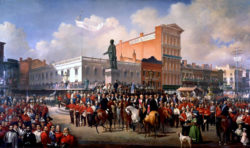Paul Poincy
Though regarded as one of the best portrait painters in New Orleans's history, Paul Poincy's genre works are his most widely recognized.

Courtesy of Louisiana State Museum
Volunteer Firemen's Parade. Victor Pierson (artist), Paul E. Poincy (artist)
Paul Édouard Poincy was a painter who worked in New Orleans in the nineteenth century. His subjects ranged from portraits, especially of children, to religious subjects, street scenes, still lifes, landscapes, and other large works on which he collaborated with other artists. In the early twentieth century, he was described as an artist who could “have lived in the days of Raphael, when art was consecrated to the church.”
Poincy was born in New Orleans in 1833 to the Marquis Rosignol des Dunes de Poincy and Louise Allemand de Chateauneuf. He was educated by the Jesuits at Grand Coteau, Louisiana, and in St. Louis, Missouri. He continued his studies in Paris for six years, initially studying under Charles Porphyre-Alexandre-Desains. Later, in 1853, he worked in the studios of Léon Cogniet and Charles Gleyre at the École des Beaux-Arts. Between 1853 and 1854, Poincy copied paintings in the Louvre by seventeenth-century French masters Eustache Le Sueur, Nicolas Poussin, and Philippe de Champaigne, and Dutch and Flemish artists Ferdinand Bol and Anthony Van Dyck.
In the late 1850s, Poincy returned to the United States, first working in Alabama and then in New Orleans, opening a studio at 6 Royal Street. He also shared a studio with Richard Clague Jr. In 1859, an article in the New Orleans Bee described a “remarkable” painting by Poincy for the Jesuit church, Immaculate Conception, which assured him a “brilliant future,” and that in his portraiture, Poincy wished to express “the moral characteristic of the physiognomy.”
In 1861, he married Marie Durel, with whom he had a son, who died in infancy, and three daughters, who often appear in his paintings. Poincy served in the Confederate Army throughout the Civil War.
In 1872, Poincy, Victor Pierson, and possibly Theodore Moïse collaborated on a large canvas, the Volunteer Firemen’s Parade, measuring six by nine feet. For this remarkable work of collaboration—photographs by Theodore Lilienthal were used as models—Poincy painted more than fifty individual portraits of New Orleans firemen gathered around a statue of Henry Clay at the corner of Royal and Canal streets.
In 1885, the Times-Democrat alluded to difficulties in postbellum New Orleans with Poincy’s observation that art in the city was “in transition” and that his principal products had become “potboilers” because his former patrons no longer had the means to buy art. Those who had recently acquired money, he claimed, did not have a taste for art.
Poincy was a member of the Southern Art Union. In 1886 he and other artists founded the Artists’ Association of New Orleans. He served as its secretary and treasurer, and he taught perspective drawing at the association’s art school. Poincy regularly exhibited there as well as at Tulane University, Seebold’s Gallery, and Lilienthal’s Gallery. He also served on the jury of the 1897 Tennessee Centennial Exposition in Nashville. He died on November 14, 1909, in New Orleans. In 1911, Poincy and Richard Clague’s names were carved into an exterior frieze on the Isaac Delgado Museum, now the New Orleans Museum of Art. They remain the only Louisiana artists to receive that honor.
